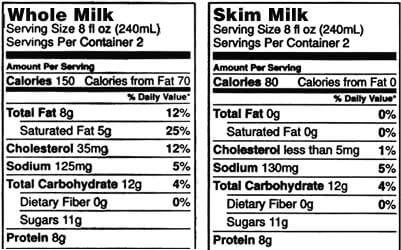
Vitamin D maintains proper levels of calcium and phosphorus, which can help build and maintain bones.Protein builds bones, muscles, cartilage, skin, blood, enzymes, hormones and vitamins.Here are the nutrients you can find on the label and why they are important to your health:Ĭhoose milk and plant-based milk alternatives that are higher in protein, vitamin D, calcium and potassium. Some of the key nutrients found in dairy products are required to be listed on the Nutrition Facts label, including calcium, vitamin D and potassium. Other plant-based milk alternatives may have calcium and be a source of calcium, but they aren’t included in the dairy group because their overall nutritional content isn’t similar to milk or fortified soy milk, according to the Dietary Guidelines. Soy beverages fortified with calcium, vitamin A, and vitamin D are included in the dairy group in the Dietary Guidelines because they are similar to milk based on their nutrient composition and use in meals. Three of these nutrients - calcium, potassium and vitamin D - are among those flagged by the Dietary Guidelines as dietary components of public health concern because people aren’t consuming enough of them. Key Nutrientsĭairy foods, including milk and fortified soy beverages, are recommended in the federal government’s Dietary Guidelines as part of a healthy dietary pattern.ĭairy foods provide important nutrients that include protein, calcium, vitamin A, vitamin D, magnesium, phosphorus, potassium, riboflavin, vitamin B12, zinc, choline, and selenium. If you are choosing a plant-based milk alternative because you are counting calories, check the nutrition label because some alternatives may actually be higher in calories than nonfat and low-fat milk, or may be much lower in protein than milk. Nuts such as almond, cashew, coconut, hazelnut, macadamia, peanut, pistachio and walnut.īecause these are non-dairy products, they may offer an option for people who are allergic to milk or want to avoid dairy products for dietary reasons or personal preference.“The label can help you choose the best products to meet your nutrient needs and those of your family.” Plant-Based Milk AlternativesĪlthough many plant-based milk alternatives are labeled with names that have the word “milk”, these products are made from plant sources, not milk. “The Nutrition Facts label on the packaging can help you compare the nutrient content of the various plant-based milk alternatives to milk,” said Dr. “Has the product been fortified with nutrients such as calcium? How much added sugar is in the product? What is the protein content?”



“The nutrients you get from plant-based milk alternatives can depend on which plant source is used, the processing methods, and added ingredients, so check the label carefully,” said Susan Mayne, Ph.D., Director of the Center for Food Safety and Applied Nutrition at the U.S. So, what should you look for when choosing plant-based milk alternatives? Soy beverages fortified with calcium, vitamin A and vitamin D are the only plant-based alternatives with a nutrient content similar enough to milk to be included in the dairy group in the federal government’s Dietary Guidelines for Americans. While many plant-based milk alternatives have the word “milk” in their name, the nutritional content can vary between the products, and many of them don’t have the same amount of calcium and vitamin D or other nutrients as milk.

Along with milk, there’s a growing variety of plant-based milk alternatives. The milk section of the dairy case isn’t what it used to be.


 0 kommentar(er)
0 kommentar(er)
